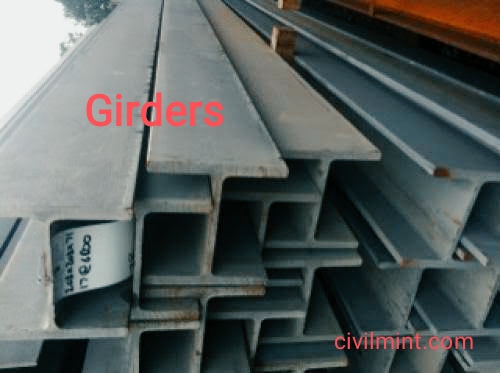Table of Contents
Introduction of Girder
A girder is a member of a structural design system. Both girders and beams have the same function. These two elements carry and distribute structural loads. Many people equate bars and grids, but they are not. Both share the same functionality, but there are some key differences that distinguish them.

This article explains what a girder is and what are the main differences between a girder and a beam. We hope that after reading this article, your doubts regarding both will be cleared.
Let’s take deep dive into the article.
What is Girder?
Girders are basically load-bearing elements like beams. Alternatively, we can say that the girder is a special type of horizontal beam that carries concentric loads like beams and columns. The girder cross-section mainly consists of I-section or box type and is specially designed to carry large concentric loads.
The payload capacity of the
Girder is significantly higher than other beams.Girders are used in many framing systems such as buildings, bridges and roofs.
Before we can distinguish between beams and girders, we need to learn about beams.
What is Beam?
A beam is a structural member whose cross-section is much smaller compared to its length and is primarily used to support and distribute loads in lateral conditions. Beams are subjected to various loads, bending moments, shear forces, etc. and are mainly used for structural members such as trusses and bridges.
Differences Between Girder and Beam
In the below table, I have listed the key differences between Girder and Beam.
| Girder | Beam |
| The main function of girders is to support other beams and receive concentric loads from beams and columns. | Beams are important components of structural framing systems. Used to distribute and support structural loads, subject to bending forces and moments. |
| Beams cannot be identified by their size, but they are often shown to be larger than beams. | The beam is small and supported by girders. |
| A girder is primarily a carrier with a specific application. There is no specific classification, but generally two types of girders are used. First is I Section Girder and second is Box Section Girder | Beams can be classified in various ways, such as: By Support: Cantilever Beam, Simply Supported Beam, Overhang Beam, By Section: I Beam, T Beam, Circular Beam, By Shape: Straight Beam, Curved Beam, Tapper Beam, etc. |
| A beam’s primary function is to support other beams and supports. | A beam’s main function is to carry and distribute loads. Loads are mainly transmitted to beams. |
| Ultimately, as we know, all load transfer to the girder has to be stronger. | Beam load capacity is much lower than beam load capacity. |
Conclusion
Both girders and beams are structural elements with small cross-sections and long lengths. Both are used to carry structural loads, but girders are stronger than beams and are predominantly horizontal.
Girders are used to support other beams and columns. You could say that all girders are beam, but all beams are not girders. Both are the backbone of the structural framing system.
I hope you enjoyed this article. If you have any confusion, please comment below.
Thanks for reading this article.
Faqs
A girder serves as a fundamental structural element in construction, providing vital support and stability to other components within a building or structure. Its primary purpose is to distribute the load and forces imposed on it to the supporting columns or piers, ensuring structural integrity and safety.
Girders and beams, though both integral to construction, possess distinguishing characteristics. Girders typically possess larger dimensions and higher load-bearing capacities compared to beams. They are designed to support multiple beams or other structural elements, while beams generally span shorter distances between supports.
Construction incorporates diverse types of girders to suit specific requirements. These include I-beams, box girders, plate girders, and truss girders. I-beams feature an “I” shape and find extensive use in building construction. Box girders, characterized by a rectangular or square cross-section, are commonly employed in bridge construction. Plate girders are fabricated by welding steel plates together to form a beam-like structure, while truss girders consist of interconnected triangles for enhanced strength.
The installation process of girders typically involves a series of steps. First, the supporting columns or piers are constructed to provide a stable foundation. Subsequently, the girders are lifted and positioned atop these supports, ensuring precise alignment and secure connections. The girders are then securely fastened to the supporting elements using bolts or welding, depending on the design and materials employed. Finally, additional structural components such as beams or joists are connected to the girders, completing the load-bearing system.
When selecting girders for construction projects, several factors warrant careful consideration. These include anticipated load requirements, span length, available headroom, required clearances, and adherence to the overall structural design. Collaboration with structural engineers and adherence to building codes and regulations are crucial to ensure that the chosen girders meet the project’s safety standards and performance expectations.
